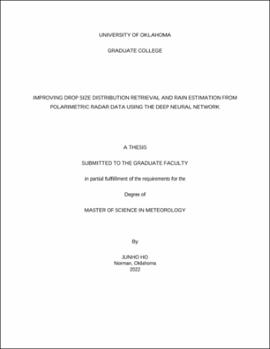| dc.description.abstract | Drop size distribution (DSD) and rain rate (R) have been estimated from polarimetric radar data are now available nationwide. DSD and R are essential in understanding rain microphysics. Past studies utilized parametrized equations or empirical formulas to estimate the parameters for DSD retrieval and R estimation. The parametrized equations and empirical formulas are relatively easy to form and provide high interpretability, but often lack flexibility, nonlinearity in linear domain, and can only partially account for observational errors. The machine learning methods are often used to address these limitations. Previous machine learning approaches have been utilized, but these efforts centered solely on rain estimation rather than DSD retrievals. This study focused on estimating both DSD parameters and R using deep learning to improve understanding of precipitation microphysics and R estimation.
The estimation accuracy degrades depending on errors in the radar measurements and estimation methods. Here, the deep neural network (DNN) approach has been utilized to improve the estimation of DSD and rain rate by mitigating these error effects. The performance of this approach was verified with the ground truth observed by two-dimensional video disdrometer (2DVD) in Kessler Farm, Oklahoma, and compared with the conventional estimation methods for the period 2006−2017. Physical parameters (mass-/volume-weighted diameter and liquid water content), rain rate, and polarimetric radar variables (including radar reflectivity and differential reflectivity) were obtained from the DSD data. The three methods physics-based inversion, empirical formula, and DNN were applied to two different temporal domains (instantaneous and rain-event-total) with three diverse error sources (fitting, measurement, and model errors). The DSD and rain estimations from the total 18 (= 3 × 2 × 3) cases were evaluated by calculating the bias and root mean squared errors (RMSE). DNN produced the best performance for most cases, up to 50% reduced RMSE when model errors existed. DSD parameters and rain estimated from the Oklahoma City polarimetric radar using the empirical and DNN methods were compared to the disdrometer observations; the number of outliers and errors reduced significantly (up to 5% bias and 40% RMSE) using DNN. The present results suggest that DNN would be useful for retrievals from radar observations. | en_US |
